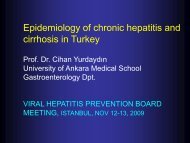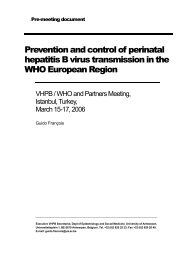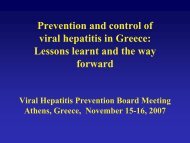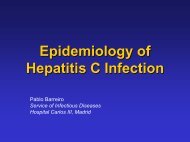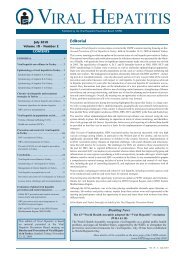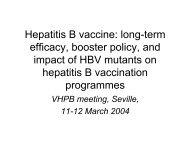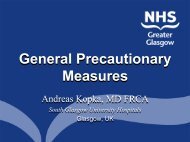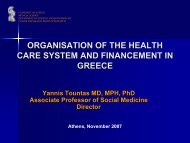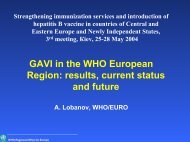Hepatitis B
Hepatitis B
Hepatitis B
You also want an ePaper? Increase the reach of your titles
YUMPU automatically turns print PDFs into web optimized ePapers that Google loves.
Objectives of the presentation<br />
Review progress in the prevention<br />
and control of hepatitis B in Italy, , 12<br />
years after the implementation of<br />
universal vaccination.<br />
Present a recent study on the<br />
duration of immunity and on the need of<br />
a booster policy to mantain lifelong<br />
protection. 2
Burden of hepatitis B in Italy<br />
in the early 1980s<br />
• 1.5 million chronic carriers<br />
• 9000 deaths per year due to HBV-related diseases<br />
• Annual incidence for acute hepatitis around 12 per<br />
10 5 (nearly 8000 new cases per year)<br />
• Number of infections per year at least 5-105<br />
times the<br />
number of reported cases (40.000-80.000)<br />
• Highest attack rate (41 x 10 5 ) for acute hepatitis B<br />
observed in people 15-24 old, reflecting risk<br />
behaviours like i.v. drug use and multiple sexual<br />
partners<br />
• Wide spread of hepatitis delta, especially among<br />
IVDUs<br />
3
Rationale:<br />
Italian strategy<br />
for hepatitis B vaccination<br />
• To protect children from HBV infection which<br />
can result in high rates of carrier state and CLD<br />
• To protect adolescents prior to the exposure to<br />
HBV by the sexual route or through drug use<br />
• To control the disease within a short period of<br />
time<br />
• To control and prevent hepatitis Delta<br />
4
Universal hepatitis B vaccination<br />
programme in Italy<br />
Law n° n 165 of May 27, 1991 established:<br />
‣ Compulsory vaccination of infants and of<br />
adolescents during their 12 th year of age (end of<br />
adolescent programme: 2003)<br />
‣ Mandatory HBsAg screening for all pregnant<br />
women during the last 3 months of pregnancy<br />
‣ Active offer of free-of<br />
of-charge vaccination to<br />
subjects belonging to categories at risk<br />
5
Italian strategy<br />
for hepatitis B vaccination<br />
age<br />
24<br />
24<br />
12<br />
12<br />
6<br />
0<br />
1991<br />
years<br />
2003<br />
0<br />
STOP<br />
vaccination<br />
of 12-years<br />
years-old
Coverage with 3 doses of hepatitis B vaccine<br />
(95%confidence intervals) at 24 months of<br />
age in 20 Italian Regions, 1998<br />
(Salmaso<br />
S. et al., Bull. WHO, 1999)<br />
Abruzzo 94.8% (91.4-98.2)<br />
98.2) Basilicata 99.1% (97.8-100)<br />
Calabria 94.8% (91.7-97.9)<br />
97.9)<br />
Campania 97.6% (81.3-93.9)<br />
Emilia R. 97.6% (95.7-99.6)<br />
99.6) Friuli V.G 97.6% (95.7-99.6)<br />
99.6)<br />
Liguria 97.6% (95.3-100)<br />
Lombardia 97.6%(95.7-99.6)<br />
99.6) Marche 94.8% (90.4-99.1)<br />
99.1)<br />
Molise 89.1% (82.0-96.3)<br />
Bolzano 85.6% (80.6-90.7)<br />
Trento 98.1% (96.3-99.9)<br />
99.9)<br />
Piemonte 98.6% (95.8-100)<br />
Puglia 93.0% (89.1-96.9)<br />
96.9) Sardegna 95.2% (92.4-98.0)<br />
98.0)<br />
Sicilia 91.1% (86.1-96.1)<br />
Toscana 95.2% (92.4-98.0)<br />
98.0) Umbria 98.6% (97.0-100)<br />
Val d’Aosta 100 Veneto 97.6% (95.7-99.6)<br />
99.6)<br />
7
Coverage of infants and adolescents with 3 doses of<br />
hepatitis B vaccine in Tuscany, central Italy<br />
Year<br />
(3.5 million inhabitants)<br />
(Bonanni<br />
P. et al, Pediatr Infect Dis J 1999; 18: 677-82)<br />
Infants<br />
Eligible Vaccinated % Eligible<br />
Adolescents<br />
Vaccinated %<br />
1992 1111 1061 95.5 1560 1540 98.7<br />
1993 2122 1922 90.5 1594 1512 94.8<br />
1994 2109 2053 97.3 1932 1812 93.7<br />
1995 1995 1935 97.0 2055 1968 95.7<br />
1996 2060 1943 94.3 2166 2065 95.3<br />
1997 1767 1692 95.8 1793 1702 94.9<br />
TOTAL 11164 10606 95.0 11100 10599 95.4<br />
8
Morbidity rate (x 10 5 inhabitants) ) of<br />
hepatitis B in Italy, , by age (1985-2002)<br />
Cases/100.000<br />
45<br />
40<br />
35<br />
30<br />
25<br />
20<br />
15<br />
10<br />
Mandatory vaccination<br />
introduced<br />
Age group:<br />
0-14<br />
15-24<br />
25 +<br />
Total<br />
9<br />
5<br />
0<br />
1985 1987 1989 1991 1993 1995 1997 1999 2001<br />
SEIEVA
Study on the incidence of hepatitis B in<br />
Tuscany, Central Italy, 1994-2001<br />
Data on notifications of acute hepatitis B and<br />
information on disease cases were collected thanks<br />
to the collaboration of Regional Health Authorities<br />
Vaccination status, number and time of possible<br />
doses administered were collected for each notified<br />
case of acute disease<br />
Modifications of incidence were calculated by 5-5<br />
year age groups between 0 and 29 years, 10-year<br />
age groups between 30 and 49 years, and globally<br />
over 50 years of age 10
Results<br />
‣1032 cases of acute hepatitis B were notified in<br />
Tuscany from 1994 to 2001 (average yearly<br />
incidence: 3,7/100000)<br />
‣From 1994 to 2001, the incidence in the 20-24 24 year<br />
age group turned from 14,3 to 3,7/100000; in the 15-<br />
19 year age group it declined from 7,3 to 1,3/100000<br />
18<br />
Incidence x 100,000<br />
16<br />
14<br />
12<br />
10<br />
8<br />
6<br />
4<br />
2<br />
0 - 4<br />
5 - 9<br />
10 - 14<br />
15 - 19<br />
20 - 24<br />
25 - 29<br />
30 - 39<br />
40 - 49<br />
50 - 90<br />
0<br />
1994 1995 1996 1997 1998 1999 2000 2001<br />
11
Incidence of acute hepatitis B in selected age groups<br />
in Tuscany, Central Italy (1994-2001)<br />
(Bonanni<br />
et al., Vaccine 2003; 21:685-691)<br />
691)<br />
12<br />
Incidenza x 100000<br />
18<br />
16<br />
14<br />
12<br />
10<br />
8<br />
6<br />
4<br />
2<br />
0<br />
1994 1995 1996 1997 1998 1999 2000 2001<br />
15 - 19<br />
Incidenza x 100000<br />
18<br />
16<br />
14<br />
12<br />
10<br />
8<br />
6<br />
4<br />
2<br />
0<br />
1994 1995 1996 1997 1998 1999 2000 2001<br />
20 - 24<br />
18<br />
18<br />
16<br />
16<br />
14<br />
14<br />
Incidenza x 100000<br />
12<br />
10<br />
8<br />
6<br />
25 - 29<br />
Incidenza x 100000<br />
12<br />
10<br />
8<br />
6<br />
30 - 39<br />
4<br />
4<br />
2<br />
2<br />
0<br />
1994 1995 1996 1997 1998 1999 2000 2001<br />
0<br />
1994 1995 1996 1997 1998 1999 2000 2001
A seroepidemiological study on 394 blood samples<br />
collected in Tuscany showed:<br />
• The absence of HBsAg positive subjects up to 22 years<br />
of age<br />
• A prevalence of anti-HBc positive subjects of 0.3% in<br />
cohorts interested by mandatory vaccination and of<br />
6.6% in those not included in the programme<br />
(statistically significant difference χ 2 = 15,2<br />
p=0,0001). 13
Epidemiological impact of universal<br />
hepatitis B vaccination in a hyperendemic<br />
area (Afragola(<br />
Afragola, , southern Italy)<br />
(Da<br />
Villa G. et al., Res Virol 1998)<br />
• Pilot project of universal hepatitis B vaccination<br />
introduced in 1983<br />
• Incidence of acute hepatitis B before vaccination:<br />
63/100,000<br />
• Anti-HBc<br />
and HBsAg prevalence rates: 66.9% and<br />
13.4%<br />
• In 1997 (after 15 years of universal infant<br />
immunization), the incidence had dropped to<br />
3/1000,000 population<br />
• Anti-HBc<br />
in 1997: 34.2%; HBsAg in 1997: 3.7%<br />
(change from 6.8% to 0.7% in young children and<br />
adolescents)<br />
• HBV was involved in 48% of chronic liver pathologies<br />
in 1982, but only in 18% in 1997<br />
14
<strong>Hepatitis</strong> B:<br />
the current epidemiological situation<br />
in Italy<br />
• about 500.000 HBsAg carriers<br />
• HBV infections still occur in unvaccinated people<br />
due to:<br />
injecting drugs<br />
sexual exposure<br />
nosocomial<br />
transfusion<br />
(risk extremely low)<br />
15
<strong>Hepatitis</strong> B vaccination:<br />
persistence of immunity<br />
How long does immunity last<br />
Will vaccinated babies maintain<br />
immunity until the time when risk<br />
behaviour may be expected<br />
Is there a need for booster vaccination(s)<br />
to sustain immunity<br />
16
Study population (1)<br />
1212 children* (50.5%M, 49.5%F)<br />
vaccinated when infants<br />
Year of vaccination:<br />
1992 (69.9%) 1993 (30.1%)<br />
Mean age (at enrollement):<br />
10.9 years<br />
North 30.7% South 69.3%<br />
* Torino<br />
*<br />
Cagliari<br />
* Pordenone<br />
* Udine<br />
* Cesena<br />
* Savignano<br />
Napoli<br />
*<br />
* Bari<br />
Potenza *<br />
* all born to HBsAg - mother<br />
*<br />
Licata<br />
*<br />
Catania<br />
17
Study population (2)<br />
521 Italian recruits<br />
vaccinated at 12 years of age<br />
Years of vaccination: 1992-93<br />
93<br />
Mean age (at enrollment):<br />
21.6 years<br />
North 25.5% South 74.5%<br />
18
Methodology<br />
2003: testing for anti-HBc<br />
and anti-HBs<br />
(titre)<br />
anti-HBc<br />
HBc+<br />
HBsAg<br />
HBV DNA<br />
sequencing<br />
anti-HBs<br />
≤10mIU/ml<br />
administration of 1 booster dose<br />
anti-HBs<br />
>10mIU/ml<br />
considered<br />
immune<br />
anti-HBs<br />
Conclusions (1)<br />
• Coverage with hepatitis B vaccination in infants and<br />
adolescents is on average >90%, and exceeds 95% in many<br />
areas of Italy<br />
• Surveillance on acute hepatitis B cases consistently shows a<br />
decline of notifications, especially in the 15-24 years age<br />
group<br />
• Data from Tuscany and from the rest of Italy show the<br />
virtual absence of acute HB cases in subjects belonging to<br />
compulsorily vaccinated cohorts who completed the<br />
immunization course<br />
• Long-term surveillance on children born to HBsAg positive<br />
mothers shows the occurrence of a very limited number of<br />
asymptomatic infections in vaccinees. . At present, mutant<br />
viruses do not pose a threat to universal vaccination<br />
programmes in the country<br />
22
Conclusions (2)<br />
• Sero-epidemiological epidemiological data on anonymous sera confirm the<br />
high level of protection in the cohorts subject to mandatory<br />
vaccination<br />
• The steady incidence in older age groups, and the<br />
demonstration of the role of sexual and iatrogenic exposures<br />
(Stroffolini<br />
et al., J Hepatol 2000; 33: 980-985)<br />
985) stress the importance to<br />
complement routine immunization with non-immunological<br />
preventive measures<br />
• A study on persistence of immunity 12 years after<br />
implementation of universal vaccination indicates that up to<br />
now no booster dose is needed to reinforce protection<br />
• The results presented here consistently demonstrate the deep<br />
impact ‘on the field’ of the first universal hepatitis B<br />
vaccination programme implemented in an industrialized<br />
country<br />
23





